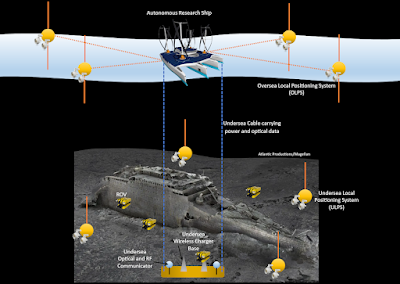This idea evolved in my mind couple of years ago while I was reading Clive Cussler’s Dirk Pitt adventures. Autonomous, remotely operated undersea research platform. Let me explain it over the wreck of Titanic.
The bots making the platform would be carried by a robotic catamaran. The boat would use sails for long distance navigation and then utilize solar panels and wind turbines to utilize electric propulsion on the research site. If the exact location of the wreck is known, the research boat will stop at that location. Then, deploy OLPS (Oversea Local Positioning System). OLPS is a small boat that carries a GPS antenna and an underwater RF transmitter attached under it. OLPS will be connected to the main boat with a tether that has power and optical data connectivity.
I propose tether cables to have two aluminum wires for high voltage ac power transmission. The insulator between the wires will be special optical cables to allow high speed data connectivity. As a result, the tethers will be small in diameter and lighter compared to traditional ones.
I also propose low frequency RF transceivers for local positioning. RF technologies developed for 6G and Starlink would be adapted to lower frequencies to allow distant low bandwidth underwater RF communication.
After OLPS is deployed, the main boat will lower an underwater power and communication base. The base will be connected to the boat using tethers. The base will have thrusters to position itself close to the wreck guided by OLPS. The base will have low frequency RF transceiver, underwater optical transceiver and conical wireless chargers for ROVs (Remotely Operated Vehicle) and ULPS (Undersea Local Positioning System). ULPS is an ROV that carries a low frequency RF transmitter to allow other ROVs to guide themselves more precisely underwater. The conical wireless charger will be covered by rubber to seal between the charger and the ROVs bottom while wireless charging.
The communication between the base station and the ROVs will be established by low frequency RF (low bandwidth) and wireless optical repeaters (higher bandwidth). Once the ROVs return to the base for recharging, they will upload the detailed information they gathered via tether’s optical cables. OLPS and ULPS will allow the ROVs to autonomously navigate within a wreck. This process would not require high bandwidth communication. After the uploading of data to the main boat and the remote scientists’ analysis, ROVs would be re-programmed to explore further.

No comments :
Post a Comment